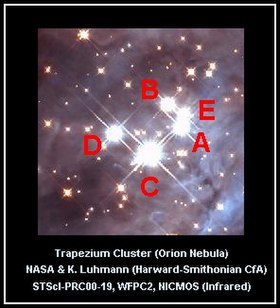 θ Orionis E and nearby stars in the Trapezium Cluster | |
| Observation data Epoch J2000 Equinox J2000 | |
|---|---|
| Constellation | Orion |
| Right ascension | 05 35 15.773 |
| Declination | −05° 23′ 10.02″ |
| Apparent magnitude (V) | 11.40 - 11.81 |
| Characteristics | |
| Evolutionary stage | PMS |
| Spectral type | G2 IV |
| Variable type | Eclipsing |
| Astrometry | |
| Radial velocity (Rv) | 34.3 km/s |
| Proper motion (μ) | RA: 1.45±0.03 mas/yr Dec.: 1.02±0.08 mas/yr |
| Parallax (π) | 2.557 ± 0.051 mas |
| Distance | 1,280 ± 30 ly (391 ± 8 pc) |
| Absolute magnitude (MV) | +1.43 |
| Orbit | |
| Period (P) | 9.89520 ± 0.0007 days |
| Semi-major axis (a) | 34.430 ± 0.193 R☉ |
| Eccentricity (e) | < 0.001 |
| Inclination (i) | 73.7 ± 0.9° |
| Semi-amplitude (K1) (primary) | 84.2 ± 1.2 km/s |
| Semi-amplitude (K2) (secondary) | 84.6 ± 1.3 km/s |
| Details | |
| A | |
| Mass | 2.807 ± 0.048 M☉ |
| Radius | 7.1 R☉ |
| Luminosity | 29 L☉ |
| Temperature | 6,000 K |
| Rotational velocity (v sin i) | 37 km/s |
| B | |
| Mass | 2.797 ± 0.048 M☉ |
| Radius | 7.1 R☉ |
| Luminosity | 29 L☉ |
| Temperature | 6,000 K |
| Rotational velocity (v sin i) | 37 km/s |
| Age | 500 Myr |
| Other designations | |
| 41 Ori E, BD−05°1315E, COUP 732, 2MASS J05351577-0523100 | |
| Database references | |
| SIMBAD | data |
θ Orionis E (Latinised as Theta Orionis E) is a double-lined spectroscopic binary located 4' north of θ Orionis A in the Trapezium Cluster. The two components are almost identical pre-main-sequence stars in a close circular orbit, and they show shallow eclipses that produce brightness variations of a few tenths of a magnitude.

Each component of the binary system is slightly under 3 M☉. Although they have a subgiant spectral classification, they are still contracting onto the main sequence and are estimated to be only about 500 million years old. It is estimated that they will reach the main sequence as smaller hotter late-B stars.
The variability was first reported in 1954 and confirmed as an eclipsing binary in 2012. It has not been assigned a variable star designation but is listed in the New Catalogue of Suspected Variable Stars.
References
- ^ Cutri, Roc M.; Skrutskie, Michael F.; Van Dyk, Schuyler D.; Beichman, Charles A.; Carpenter, John M.; Chester, Thomas; Cambresy, Laurent; Evans, Tracey E.; Fowler, John W.; Gizis, John E.; Howard, Elizabeth V.; Huchra, John P.; Jarrett, Thomas H.; Kopan, Eugene L.; Kirkpatrick, J. Davy; Light, Robert M.; Marsh, Kenneth A.; McCallon, Howard L.; Schneider, Stephen E.; Stiening, Rae; Sykes, Matthew J.; Weinberg, Martin D.; Wheaton, William A.; Wheelock, Sherry L.; Zacarias, N. (2003). "VizieR Online Data Catalog: 2MASS All-Sky Catalog of Point Sources (Cutri+ 2003)". CDS/ADC Collection of Electronic Catalogues. 2246: II/246. Bibcode:2003yCat.2246....0C.
- ^ Kukarkin, B. V.; Kholopov, P. N.; Artiukhina, N. M.; Fedorovich, V. P.; Frolov, M. S.; Goranskij, V. P.; Gorynya, N. A.; Karitskaya, E. A.; Kireeva, N. N.; Kukarkina, N. P.; Kurochkin, N. E.; Medvedeva, G. I.; Perova, N. B.; Ponomareva, G. A.; Samus, N. N.; Shugarov, S. Y. (1981). "Catalogue of suspected variable stars. Moscow, Acad. Of Sciences USSR Shternberg,1951 (1981)". Nachrichtenblatt der Vereinigung der Sternfreunde E.V. (1981). Bibcode:1981NVS...C......0K.
- ^ Morales-Calderón, M.; Stauffer, J. R.; Stassun, K. G.; Vrba, F. J.; Prato, L.; Hillenbrand, L. A.; Terebey, S.; Covey, K. R.; Rebull, L. M.; Terndrup, D. M.; Gutermuth, R.; Song, I.; Plavchan, P.; Carpenter, J. M.; Marchis, F.; García, E. V.; Margheim, S.; Luhman, K. L.; Angione, J.; Irwin, J. M. (2012). "YSOVAR: Six Pre-main-sequence Eclipsing Binaries in the Orion Nebula Cluster". The Astrophysical Journal. 753 (2): 149. arXiv:1206.6350. Bibcode:2012ApJ...753..149M. doi:10.1088/0004-637X/753/2/149. S2CID 44908832.
- ^ Costero, R.; Allen, C.; Echevarría, J.; Georgiev, L.; Poveda, A.; Richer, M. G. (2008). "The Escaping Spectroscopic Binary θ^1 Ori E". IV Reunión Sobre Astronomía Dinámica en Latino América (Eds. C. Allen. 34: 102. Bibcode:2008RMxAC..34..102C.
- Olivares, J.; Sánchez, L. J.; Ruelas-Mayorga, A.; Allen, C.; Costero, R.; Poveda, A. (2013). "Kinematics of the Orion Trapezium Based on Diffracto-Astrometry and Historical Data". The Astronomical Journal. 146 (5): 106. arXiv:1310.0769. Bibcode:2013AJ....146..106O. doi:10.1088/0004-6256/146/5/106. S2CID 119110490.
- ^ Kounkel, Marina; et al. (2017). "The Gould's Belt Distances Survey (GOBELINS) II. Distances and Structure toward the Orion Molecular Clouds". The Astrophysical Journal. 834 (2). 142. arXiv:1609.04041. Bibcode:2017ApJ...834..142K. doi:10.3847/1538-4357/834/2/142. S2CID 26439367.
- ^ Herbig, G. H.; Griffin, R. F. (2006). "Θ1 Orionis E as a Spectroscopic Binary". The Astronomical Journal. 132 (5): 1763. Bibcode:2006AJ....132.1763H. doi:10.1086/507769.
- ^ Huenemoerder, David P.; Schulz, Norbert S.; Testa, Paola; Kesich, Anthony; Canizares, Claude R. (2009). "X-Ray Emission and Corona of the Young Intermediate-Mass Binary θ1 Ori E". The Astrophysical Journal. 707 (2): 942–953. arXiv:0911.0189. Bibcode:2009ApJ...707..942H. doi:10.1088/0004-637X/707/2/942. S2CID 55747631.
| Constellation of Orion | |||||||||||||
|---|---|---|---|---|---|---|---|---|---|---|---|---|---|
| Stars |
| ||||||||||||
| |||||||||||||
| Star clusters |
| ||||||||||||
| Nebulae |
| ||||||||||||
| Galaxies |
| ||||||||||||
| |||||||||||||